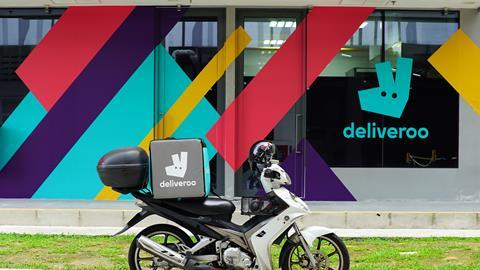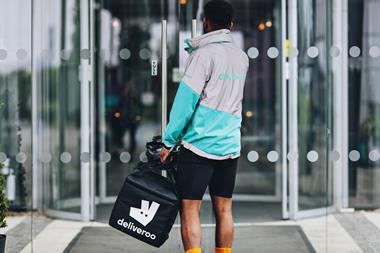As we look back on a year since the UK first went into lockdown, it’s clear some of the new eating and shopping habits we’ve developed while stuck at home are here to stay. Not least our newfound obsession with home delivery.
It’s appropriate, then, that Deliveroo has chosen this week to publish its prospectus ahead of its coming blockbuster IPO. And one thing is clear: Deliveroo sees its future beyond mere takeaways. “Our mission is to be the definitive online food company,” it says. “We want to be the platform that people turn to whenever they think about food.”
Over the past year, it’s undeniably made major inroads into grocery, striking up partnerships with Sainsbury’s, Waitrose, M&S, Morrisons and Aldi. And this year Deliveroo will extend availability of grocery deliveries via its platform to a further 125 towns and cities.
But is online grocery the “massive, under-penetrated total addressable market” Deliveroo portrays it as, in order to woo new investors?
Deliveroo points to OC&C analysis that puts market opportunity globally for online grocery at £883bn – twice as big as it reckons the restaurant delivery opportunity to be. Furthermore, OC&C estimates quoted in the prospectus put online channel penetration at 3% of all grocery across Deliveroo’s countries of operation.
As Deliveroo puts it: “We believe that online penetration of convenience grocery is just getting started, and that there is very significant headroom.”
In the UK, things are way beyond “just getting started”. The OC&C figures quoted are from 2019, ignoring the impact of the pandemic that has seen online’s share of grocery sales reach a record 15.4% in the four weeks to 21 February, up from 8.7% last year, according to Kantar.
Based on the findings of an external third-party survey, Deliveroo says more than half of people don’t decide what to eat more than half a day in advance and so, “the traditional online model is not serving these consumers”. In fact, it’s “at odds” with their needs.
Fair enough. For the advanced planning-averse half of Brits, the survey shows about a third decide half a day before, a little over a third between one and four hours before, and the remainder are “spontaneous”. Deliveroo’s proposition unlocks their demands, it says.
But does it? The “spontaneous” group are now being better served by the sub-15 minute grocery players – one founded by former Deliveroo executives, no less – that are flooding the UK, typically with lower delivery fees than Deliveroo. Meanwhile, for the one to four-hour mission Ocado is planning 12 or more Zoom sites, offering 10,000 SKUs – significantly more than the few hundred SKUs available in the typical Deliveroo/supermarket offering.
“The fact is that only a very small niche within the grocery market is truly addressable,” says Andrew Porteous, of HSBC Global Research. “[Deliveroo’s] total addressable market analysis looks ambitious.”
Even within that niche, there’s only a subsection willing to pay Deliveroo’s fairly hefty delivery charges, which are about the same as a standard supermarket online delivery.
“There are ultimately very few £20 grocery baskets that customers are willing to pay a £3-£5 delivery charge for,” Porteous says. “This has historically even been a struggle on £100 baskets.”
So can it ever turn decent profits in that small slice of grocery delivery? It must keep fees “affordable” to retain customers, Deliveroo says. It is already facing pressure over its high commission rates on retailers. And it can hardly squeeze riders any further. Not giving them “the opportunity to earn enough” would see them leave to join wage-paying competitors.
“If Deliveroo really considers this to be its addressable market and intends to pursue it, it will likely lose a significant amount of money doing so, and face uncertainty about what the end state could look like – that is if they will ever be able to extract a profit,” Porteous says.
So, even if Deliveroo can deliver groceries to more people, more of the time, questions remain over whether it could deliver returns for investors.




















No comments yet